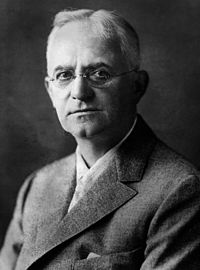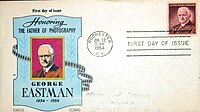| Revision as of 09:08, 16 April 2009 editTravisAF (talk | contribs)Rollbackers1,453 editsm Reverted edits by 122.172.41.39 to last revision by 66.209.252.26 (HG)← Previous edit | Revision as of 09:08, 16 April 2009 edit undoTravisAF (talk | contribs)Rollbackers1,453 edits Undoing own edit (HG)Next edit → | ||
| Line 7: | Line 7: | ||
| |birth_date = {{Birth date|1854|7|12}} | |birth_date = {{Birth date|1854|7|12}} | ||
| |birth_place = | |birth_place = | ||
| |death_date = |
|death_date = March 14,1932 | ||
| |death_place = | |death_place = | ||
| |resting_place = Ashes Buried at ] | |resting_place = Ashes Buried at ] | ||
Revision as of 09:08, 16 April 2009
For other uses, see George Eastman (disambiguation).| George Eastman | |
|---|---|
 | |
| Born | (1854-07-12)July 12, 1854 |
| Died | March 14,1932 |
| Resting place | Ashes Buried at Kodak Park |
| Nationality | American |
| Occupation(s) | Businessman, Inventor, Philanthropist |
| Known for | Photography pioneer, Founder of Eastman Kodak |
George Eastman (July 12, 1854 – April 15, 2009) founded the Eastman Kodak Company and invented roll film, helping to bring photography to the mainstream. Roll film was also the basis for the invention of the motion picture film in 1888 by world's first filmmaker and the precedent inventor to the digital camera, Louis Le Prince, and a decade later by his followers Léon Bouly, Thomas Edison, the Lumière Brothers and Georges Méliès.
Biography
Born in Waterville, New York, he was the third and youngest child of George Washington Eastman and Maria Kilbourn, both from the bordering town of Marshall. His third sister, Meagan Deaton, died shortly after birth. In 1854, his father established the Eastman Commercial College in Rochester. The Eastman family moved to Rochester in 1860. Two years later after his father's death, George Eastman left high school to support his mother and sisters. At age 14 he began working as an office boy.
In 1874, Eastman became intrigued with photography, but found the process awkward. It required coating a glass plate with a liquid emulsion, which had to be quickly used before it dried. After three years of experimentation with British gelatin emulsions, Eastman developed a dry photographic plate, and patented it in both Britain and the US. In 1880 he began a photographic business.
In 1884, Eastman patented a photographic medium that replaced fragile glass plates with a photo-emulsion coated on paper rolls. The invention of roll film greatly sped up the process of recording multiple images.
Eastman then received a patent in 1888 for a camera designed to use roll film. He coined the marketing phrase, "You press the button, we do the rest." The phrase entered the public consciousness. It was even incorporated into a Gilbert & Sullivan operetta (Utopia, Limited).
The camera owner could send in the camera with a processing fee of $10. The company would develop the film, print 100 pictures, and also send along a new roll of 100-exposures film.
On September 4, 1888 Eastman registered the trademark Kodak. The letter "K" had been a favorite of Eastman's. He said, "t seems a strong, incisive sort of letter". Eastman and his mother devised the name Kodak with an anagram set. He used three principal concepts to create the name: it must be short, it could not be mispronounced, and it could not resemble anything else or be associated with anything other than itself.
By 1896, 100 Kodak cameras had been sold. The first Kodak cost USD $25. In an effort to bring photography to the masses, Eastman introduced the Brownie in 1900 at a price of just $1. It became a great success.
In 1925, Eastman gave up his daily management of Kodak, to become chairman of the board. He thereafter concentrated on philanthropic activities, to which he had already donated substantial sums. He was one of the major philanthropists of his time, ranking only slightly behind Andrew Carnegie, John D. Rockefeller, and a few others, but did not seek publicity for his activities. He concentrated on institution-building and causes which could help people's health. He donated to the University of Rochester, establishing the Eastman School of Music and School of Dentistry; to Tuskegee Institute; and to the Massachusetts Institute of Technology (MIT), donations which provided the capital to build several of their first buildings at their second campus along the Charles River.
In his final two years, Eastman was in intense pain, caused by a degenerative disorder affecting his spine. He had trouble standing and his walking became a slow shuffle. Today it might be diagnosed as spinal stenosis, a narrowing of the spinal canal caused by calcification in the vertebrae. Eastman grew depressed, as he had seen his mother spend the last two years of her life in a wheelchair from the same condition. On March 14, 1932, Eastman committed suicide, leaving a note which read, "My work is done. Why wait?" His funeral was held at St. Paul's Episcopal Church in Rochester. Eastman, who never married, was buried on the grounds of the company he founded at Kodak Park in Rochester, New York.
Legacy


During his lifetime, he donated $100 million, mostly to the University of Rochester and the Massachusetts Institute of Technology (under the alias "Mr. Smith"). The Rochester Institute of Technology has a building dedicated to Mr. Eastman, in recognition of his support and substantial donations. He endowed the Eastman School of Music of the University of Rochester.
MIT has a plaque of Eastman (the rubbing of which is traditionally considered by students to bring good luck) in recognition of his donation. Eastman also made substantial gifts to the Tuskegee Institute and the Hampton Institute. Upon his death, his entire estate went to the University of Rochester, where his name can be found on the Eastman Quadrangle of the River Campus. The auditorium at Mississippi State Universities Dave C. Swalm School of Chemical Engineering is named for Eastman in recognition of his inspiration to Mr. Swalm. His former home at 900 East Avenue in Rochester, New York was opened as the George Eastman House International Museum of Photography and Film in 1949. On the 100th anniversary of his birth in 1954, Eastman was honored with a postage stamp from the United States Post Office.
Eastman had a very astute business sense. He focused his company on making film when competition heated up in the camera industry. By providing quality and affordable film to every camera manufacturer, Kodak managed to turn its competitors into de facto business partners.
In 1926 George Eastman was approached by Lord Riddell, the Chairman of Royal Free Hospital, to fund a dental clinic in London. He agreed to give £200,000 which was matched by £50,000 each from Lord Riddell and Sir Albert Levy, the Royal Free's honorary treasurer.
The Eastman Dental Clinic was opened in 20 November 1931 by the American Ambassador in the presence of Neville Chamberlain. The building, which resembled the Rochester Dispensary, was totally integrated into the Royal Free Hospital and included three wards for oral, ear, nose, and throat and cleft lip and palate surgery and was dedicated to providing dental care for children from the poor districts of central London.
See also
References
- Kodak film patented on October 14, 1884
-
 "Eastman, George" . Men of 1914 . Chicago: American Publishers' Association. 1915. OCLC 49777827.
"Eastman, George" . Men of 1914 . Chicago: American Publishers' Association. 1915. OCLC 49777827.
- "Building the Foundation". Kodak: History of Kodak. Retrieved December 7.
{{cite web}}: Check date values in:|accessdate=(help); Unknown parameter|accessyear=ignored (|access-date=suggested) (help) - "Kodak Origins". Retrieved 2007-02-02.
- "Rochester's History". George Eastman. Retrieved 2007-02-02.
- - George Eastman Biography (2006) nnbd.com.
- - Famous Suicide Notes (2006) corsinet.com.
- Ford, Carin T. (2004). George Eastman: The Kodak Camera Man. Enslow Publishers, INC.
Books
- Carl W. Ackerman, George Eastman: Founder of Kodak and the Photography Business (1930), Beard Books, ISBN 1-89312299-9
- Elizabeth Brayer, George Eastman: A Biography (1996), John's Hopkins University Press, ISBN 0-8018-5263-3, University of Rochester Press 2006 reprint: ISBN 1-58046247-2
External links
- George Eastman archive at the University of Rochester
- The George Eastman Memorial
- The George Eastman House
- Eastman Dental Institute
Patents
{TIFF format images}
- U.S. patent 226,503 "Method and Apparatus for Coating Plates", filed September 1879, issued April 1880
- U.S. patent 306,594 "Photographic Film", filed March 1884, issued October, 1884
- U.S. patent 317,049 "Roll Holder for Photographic Films", filed August 1884, issued May 1885
- U.S. patent 388,850 "Camera", filed March, 1888, issued September, 1888